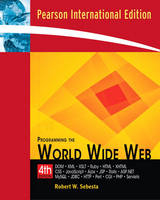
Programming the World Wide Web
Pearson (Verlag)
978-0-321-52672-4 (ISBN)
- Titel erscheint in neuer Auflage
- Artikel merken
Robert Sebesta is an Associate Professor in the Computer Science Department at the University of Colorado, Colorado Springs. Professor Sebesta received a BS in applied mathematics from the University of Colorado, Boulder, and MS and PhD degrees in computer science from the Pennsylvania State University. His professional interests are the design and evaluation of programming languages, compiler design, and software testing methods and tools. He is the author of Addison-Wesley’s Concepts of Programming Languages and Programming the World Wide Web.
Chapter 1 Fundamentals
1.1 A Brief Introduction to the Internet
1.2 The World Wide Web
1.3 Web Browsers
1.4 Web Servers
1.5 Uniform Resource Locators
1.6 Multipurpose Internet Mail Extensions
1.7 The Hypertext Transfer Protocol
1.8 Security
1.9 The Web Programmer’s Toolbox
1.10 Summary
Review Questions
Exercises
Chapter 2 Introduction to XHTML
2.1 Origins and Purposes of HTML and XHTML
2.2 Basic Syntax
2.3 Standard XHTML Document Structure
2.4 Basic Text Markup
2.5 Images
2.6 Hypertext Links
2.7 Lists
2.8 Tables
2.9 Forms
2.10 Frames
2.11 Syntactic Differences between HTML and XHTML
2.12 Summary
Review Questions
Exercises
Chapter 3 Cascading Style Sheets
3.1 Introduction
3.2 Levels of Style Sheets
3.3 Style Specification Formats
3.4 Selector Formats
3.5 Property Value Forms
3.6 Font Properties
3.7 List Properties
3.8 Color
3.9 Alignment of Text
3.10 The Box Model
3.11 Background Images
3.12 The and Tags
3.13 Summary
Review Questions
Exercises
Chapter 4 The Basics of JavaScript
4.1 Overview of JavaScript
4.2 Object Orientation and JavaScript
4.3 General Syntactic Characteristics
4.4 Primitives, Operations, and Expressions
4.5 Screen Output and Keyboard Input
4.6 Control Statements
4.7 Object Creation and Modification
4.8 Arrays
4.9 Functions
4.10 An Example
4.11 Constructors
4.12 Pattern Matching Using Regular Expressions
4.13 Another Example
4.14 Errors in Scripts
4.15 Summary
Review Questions
Exercises
Chapter 5 JavaScript and HTML Documents
5.1 The JavaScript Execution Environment
5.2 The Document Object Model
5.3 Element Access in JavaScript
5.4 Events and Event Handling
5.5 Handling Events from Body Elements
5.6 Handling Events from Button Elements
5.7 Handling Events from Text Boxes and Password Elements
5.8 The DOM 2 Event Model
5.9 The navigator Object
5.10 DOM Tree Traversal and Modification
5.11 Summary
Review Questions
Exercises
Chapter 6 Dynamic Documents with JavaScript
6.1 Introduction
6.2 Positioning Elements
6.3 Moving Elements
6.4 Element Visibility
6.5 Changing Colors and Fonts
6.6 Dynamic Content
6.7 Stacking Elements
6.8 Locating the Mouse Cursor
6.9 Reacting to a Mouse Click
6.10 Slow Movement of Elements
6.11 Dragging and Dropping Elements
6.12 Summary
Review Questions
Exercises
Chapter 7 Introduction to XML
7.1 Introduction
7.2 The Syntax of XML
7.3 XML Document Structure
7.4 Document Type Definitions
7.5 Namespaces
7.6 XML Schemas
7.7 Displaying Raw XML Documents
7.8 Displaying XML Documents with CSS
7.9 XSLT Style Sheets
7.10 XML Processors
7.11 Web Services
7.12 Summary
Review Questions
Exercises
Chapter 8 The Basics of Perl
8.1 Origins and Uses of Perl
8.2 Scalars and Their Operations
8.3 Assignment Statements and Simple Input and Output
8.4 Control Statements
8.5 Fundamentals of Arrays
8.6 Hashes
8.7 References
8.8 Functions
8.9 Pattern Matching
8.10 File Input and Output
8.11 An Example
8.12 Summary
Review Questions
Exercises
Chapter 9 Using Perl for CGI Programming
9.1 The Common Gateway Interface
9.2 CGI Linkage
9.3 Query String Format
9.4 The CGI.pm Module
9.5 A Survey Example
9.6 Cookies
9.7 Summary
Review Questions
Exercises
Chapter 10 Servlets and Java Server Pages
10.1 Overview of Servlets
10.2 Servlet Details
10.3 A Survey Example
10.4 Storing Information on Clients
10.5 Java Server Pages
10.6 Summary
Review Questions
Exercises
Chapter 11 Introduction to PHP
11.1 Origins and Uses of PHP
11.2 Overview of PHP
11.3 General Syntactic Characteristics
11.4 Primitives, Operations, and Expressions
11.5 Output
11.6 Control Statements
11.7 Arrays
11.8 Functions
11.9 Pattern Matching
11.10 Form Handling
11.11 Files
11.12 Cookies
11.13 Session Tracking
11.14 Summary
Review Questions
Exercises
Chapter 12 Introduction to ASP.NET
12.1 Overview of the .NET Framework
12.2 Overview of C#
12.3 Introduction to ASP.NET
12.4 ASP.NET Controls
12.5 Web Services
12.6 Summary
Review Questions
Exercises
Chapter 13 Database Access through the Web
13.1 Relational Databases
13.2 An Introduction to the Structured Query Language
13.3 Architectures for Database Access
13.4 The MySQL Database System
13.5 Database Access with Perl and MySQL
13.6 Database Access with PHP and MySQL
13.7 Database Access with JDBC and MySQL
13.8 Summary
Review Questions
Exercises
Chapter 14 Introduction to Ruby
14.1 Origins and Uses of Ruby
14.2 Scalar Types and Their Operations
14.3 Simple Input and Output
14.4 Control Statements
14.5 Fundamentals of Arrays
14.6 Hashes
14.7 Methods
14.8 Classes
14.9 Code Blocks and Iterators
14.10 Pattern Matching
14.11 Summary
Review Questions
Exercises
Chapter 15 Introduction to Rails
15.1 Overview of Rails
15.2 Document Requests
15.3 Processing Forms
15.4 Rails Applications and Databases
15.5 Layouts
15.6 Summary
Review Questions
Exercises
Chapter 16 Introduction to Ajax
16.1 Overview of Ajax
16.2 The Basics of Ajax
16.3 Rails with Ajax
16.4 Summary
Review Questions
Exercises
Appendices
Appendix A Introduction to Java
Appendix B Named Colors
Appendix C Java Applets
Index
| Erscheint lt. Verlag | 12.9.2007 |
|---|---|
| Sprache | englisch |
| Maße | 185 x 234 mm |
| Gewicht | 1098 g |
| Themenwelt | Informatik ► Web / Internet ► Web Design / Usability |
| ISBN-10 | 0-321-52672-4 / 0321526724 |
| ISBN-13 | 978-0-321-52672-4 / 9780321526724 |
| Zustand | Neuware |
| Haben Sie eine Frage zum Produkt? |
aus dem Bereich


